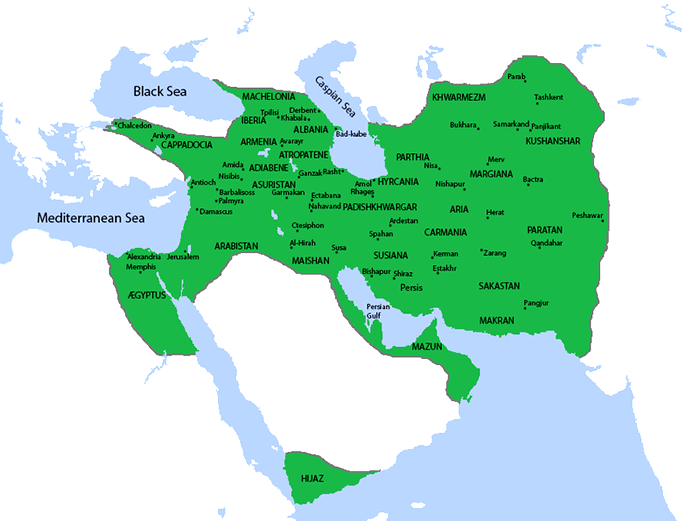 Sassanid Empire
Sassanid Empire

(Text by Duane R. Hurst © 2013)
Click on a link to view its information and pictures.
|
SASSANID LINKS: Significant Event: Maiden Castle (Ghal'eh Dokhtar) Rome Defeats Shapur in 243 AD Main Cities: Ctesiphon; Estakhr Time: 224-651 AD Language: Aramaic; Old Persian Personage: Ardashir I; Hormizd I Religion: Sassanid Gods Related Country: Afghanistan; Iran; Iraq Brief History: I have included only a few items concerning the history of this empire. A good source for more details can be found on Wikipedia or in history books. |
|
|
EARLY YEARS:
Circa 200 AD, Babak (ruler of Kheir) overthrew Gocihr and ruled the Bazrangids of modern Boir Ahmadi. In 208 AD, Ardashir seized power and founded Ardashir-Khwarrah (modern Fars). King Artabanus V of Parthia led an army to suppress Ardashir's rebellion in 224 AD. Artabanus died in the battle of Hormozgan. Ardashir ended the Parthian Empire in the same year and his Sassanid Empire continued to use Ctesiphon as its capital. Kings continued to rule from the Ctesiphon Palace. Many in the empire also embraced Manichaeism. EMPIRE EXPANSION: Ardashir conquered extensively during his reign, including such places as Balkh, Mosul, Merv and Sistan. His son, Shapur I (240-270 AD), subdued the kings of Bactria, Kushan, Makran and Turan. In 243 AD, a Roman army defeated Ardashir in the Battle of Rhesaina. However, he later triumphed over Rome at Barbalissos in 253 AD. Although he seized Antioch and attacked Anatolia, a joint Roman-Palmyrene army crushed Shapur's force in 260 AD and retook all lost Roman territory. Roman troops under Emperor Carus and general Galerius sacked Ctesiphon in 298 AD and seized much of Armenia. Emperor Narseh ceded five western provinces to Rome and promised not to interfere with Roman interests in Armenia and Georgia. GOLDEN ERA: Shapur II (309-379 AD) stabilized the empire and ushered in a golden era. Using Cataphract heavy cavalry, he led successful campaigns to seize Arab lands and Transoxiana. Byzantine legions under Emperor Julian unsuccessfully attacked Ctesiphon in 363 AD, during which Julian died in battle. In 451 AD, Armenian Christians lost the Battle of Vartanantz but won the right to worship Jesus Christ. A second Golden Era occurred between 498 and 622 AD during the reign of Kavadh I. His forces briefly retook Armenian territory from Rome in 502 AD. Sassanid troops repulsed a Byzantine attack on Nisibis in 527 AD. Byzantines won several battles such as at Dara and Satala. Both sides signed a peace treaty after Byzantium lost the Battle of Callinicum in 531 AD. Emperor Khosrau I broke the treaty in 540 AD, sacking Antioch and seizing Lazica. EMPIRE COLLAPSE: During the late 5th century AD, Hephthalite (White Hun) forces invaded the empire and extracted tribute for many years. In 484 AD, Huns annihilated Emperor Peroz I (459-484 AD) and his army as they marched towards Herat. Sassanid and Byzantine emperors allied against the rebel Sassanid general, Bahram Chobin. Chobin lost the Battle of Blarathon in 591 AD. Sassanid forces under Khosrau II resumed expansion against Byzantine territory in 602 AD. Khosrau's military campaigns exhausted the Sassanid treasury. He allied with Slavs and Avar in 626 AD unsuccessfully to besiege Constantinople. Emperor Heraclius retaliated by invading Sassanid territory, defeating their army in the Battle of Nineveh and sacking the royal palace at Dastagerd. As a result of his failed defense, the Sassanid aristocracy murdered Khosrau in 628 AD. Heavy taxes and internal strife further weakened the empire. Islamic forces began attacking the Sassanid Empire in 633 and completed the conquest in 654 AD. |
|
|
© Page Publisher: Duane R. Hurst
|


